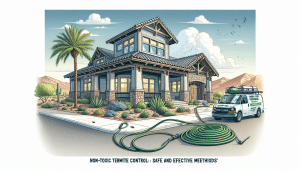When it comes to protecting your home from termite damage, prevention is key. One of the most effective ways to deter termites is by using termite-resistant building materials during construction or renovation. In this buyer’s guide, we’ll explore the various termite-resistant building materials available, helping you make informed decisions to safeguard your home from these silent invaders.
Contents
Why Choose Termite-Resistant Building Materials?
Termites pose a significant threat to the structural integrity of homes, causing extensive and costly damage. Choosing termite-resistant materials can help prevent infestations and reduce the risk of termite-related problems. Here are some advantages of using termite-resistant building materials:
1. Long-Term Protection
Termite-resistant materials are designed to withstand termite attacks for extended periods, offering lasting protection for your home.
2. Reduced Maintenance Costs
By using materials that termites find unappealing, you can minimize the need for repairs and maintenance related to termite damage.
3. Peace of Mind
Knowing that your home is constructed with termite-resistant materials provides peace of mind and confidence in your property’s durability.
4. Eco-Friendly Options
Many termite-resistant materials are environmentally friendly and have low toxicity to humans and animals, making them a sustainable choice.
Termite-Resistant Building Material Options
1. Pressure-Treated Wood
Pressure-treated wood is a common choice for termite resistance. It is infused with preservatives that deter termites and decay. Popular types include ACQ (Alkaline Copper Quaternary) and CA (Copper Azole) treated wood.
2. Naturally Resistant Woods
Certain wood species are naturally resistant to termites due to their inherent chemical properties. Examples include cedar, redwood, and cypress. These woods contain natural oils and compounds that deter termites.
3. Composite Materials
Composite building materials, such as fiber cement and plastic composites, are naturally termite-resistant and offer durability and low maintenance.
4. Metal
Materials like steel and aluminum are entirely termite-proof, making them ideal for structures where termite resistance is a top priority.
5. Concrete and Masonry
Concrete blocks and masonry materials are not attractive to termites. They are commonly used in termite-prone areas for foundations and structural components.
Choosing the Right Material
When selecting termite-resistant building materials, consider the following factors:
1. Local Termite Species
Research the types of termites common in your area. Some materials may be more effective against specific termite species.
2. Building Location
The location of the structure, such as proximity to wooded areas or moisture sources, can influence material selection.
3. Budget
Evaluate your budget and choose materials that offer the right balance between termite resistance and cost.
4. Aesthetic Preferences
Consider the appearance and style of the materials to ensure they align with your design preferences.
5. Maintenance
Some materials require more maintenance than others. Factor in the long-term maintenance requirements when making your decision.
Seek Professional Guidance
Consult with a qualified contractor or architect who specializes in termite-resistant construction. They can provide valuable insights and recommendations based on your specific needs and the local termite environment.
In conclusion, choosing termite-resistant building materials is a proactive step toward protecting your home from these destructive pests. By considering the options available and seeking professional guidance, you can create a termite-resistant structure that offers long-term durability and peace of mind. Invest in your home’s future by selecting the right materials to keep termites at bay.




